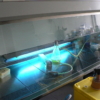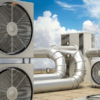Preventing Mold In Hospitals
Mold in Hospitals?
Mold is a collective term which refers to fungi that grows in the form of multi-cellular thread-like structures called hyphae as opposed to fungi that exist as single cells are called yeasts. Some molds as well as yeasts cause disease or food spoilage while others are beneficial and play an important role in biodegradation or in the production of various foods, beverages, antibiotics and enzymes. Ironically, while most mold types are potentially harmful to patients, penicillin is a mold used in hospitals that is used to actually treat patients!
In a healthcare setting, it is important to prevent mold growth of any kind where possible; even the most harmless types can cause health issues for patients with serious illnesses and compromised immune systems. A patient with a compromised immune system can be especially at risk.
Although hospitals are generally considered to be clean and sterile environments, a closer look tells us there is actually a greater potential for problematic viral, fungal and bacterial threats due to the very nature of hospitals. Think of it this way, hospitals typically house patients with severe illnesses. These illnesses can be transferred to the garments, linens, walls and floors of the hospital. This is in addition to the obvious blood and other bodily fluids transferred from patient to hospital assets. Basically, there is a lot of fluids in one form or another being transferred from patients to the hospital itself. Where there are fluids, there is the potential for mold growth.
Keeping the hospital clean for patients and preventing cross-contamination is a full-time job, usually for several personnel – and can be a real challenge.
In all hospitals, heavy cleaning agents along with water as a dilutant are used to launder linens, clean surfaces and for general-purpose sanitizing. As you probably know, where there is water, there is a potential for mold growth. Additionally, some hospitals may be older structures with leaky roofs, and foundations; allowing for even greater potential for mold growth.
In any case, prevention is key. Once mold starts to grow, it can become a devastating and never-ending cycle of growth and remediation. Keeping mold growth to a minimum requires monitoring temperature and relative humidity effectively. It may also be beneficial to monitor and correct for undesirable differential air pressures in patient rooms and entire floors. A patient room with a positive air pressure will expel air along with any pollutants in the air every time the door is opened. So any mold spores quickly move in the hall ever time someone enters or leaves the room.
Sources of Mold
Mold growth can originate in places where standing water is present or in use such as bathrooms, showers, laundry areas and kitchens. Moisture, temperature and humidity are usually monitored in these locations. However, it is usually places that are not monitored effectively where mold can start growing and thrive.
Mold in ceilings
Most hospitals have drop-tile ceilings in rooms and hallways. These are usually made of mold-resistant materials and a general inspection of these tiles usually indicates a water or moisture problem because the ceiling tiles will have visible brown or discolored areas. These may appear as circular, and start from one corner or from the middle of the tile. Sources for the water leak may be the roof (if on higher floors) or from fresh water pipes, sprinkler systems or other plumbing. The problem is, by the time you can see evidence of water leaks it is too late to prevent mold growth. You are unfortunately just seeing the “tip” of the iceberg.
There are other instances where pipes may sweat because of temperature changes and relative humidity. This creates a humid environment which facilitates mold growth, even though there may be no visible sign of water leakage. HVAC and AC systems can be an especially common source for mold growth and increased relative humidity – heated air mixed with condensation; creating an environment that is relatively tropical. As a note, tropical climates are know to exponentially increase mold, bacteria and viruses.
It is advantageous and advisable for all hospitals to install temperature and relative humidity sensors in ceilings to constantly monitor humidity and temperature. Any temperature fluctuations can lead to greater condensation and relative humidity.
For many hospitals, installing a complete system would be a challenge because of having to install wire throughout a facility to a centralized location or trying to integrate it with an existing BACnet or other building management system. Fortunately, there are wireless systems that allow hospital administrators to monitor relative humidity, differential air pressure and temperature in ceilings throughout the entire hospital without construction costs. In fact, some systems even allow for automated email alerts, text/SMS alerts with automated phone calls to management personnel or maintenance staff long before a environment becomes too humid.
Can you prevent mold growth?
Mold can grow in obvious areas like hospital kitchens, bathrooms, showers, laundry, etc. Keeping these areas dry and properly ventilated is key. It requires more than just drying up the water; the room temperature may naturally increase the relative humidity – creating an environment for mold growth. An often overlooked way to combat this higher relative humidity is by using proper ventilation via exhaust systems and monitoring differential air pressure between common “wet” areas and dryer areas. Keeping a wet area under constant positive air pressure will allow the room to “push” the damper air to areas of dryer air. As the air mixes, it will become more homogeneous and stable.
If wet areas have negative air pressure, and inadequate exhaust, the air can become overly humidified and stale. The key takeaway is “Do you actually know for sure if you have adequate pressurization and ventilation between rooms?” If not, finding out the hard way can cost millions and even result in the potential loss of life.
While mold is less common in modern/new construction hospitals, it can still happen. Simple engineering and construction inconsistencies can allow for water to slowly trickle in from outdoors or allow for unwanted condensation in plumbing and HVAC systems. The problem is, no one really knows there is a problem – until there is a problem.
After all, how many hospital staff have the job description requiring them to physically inspect all plumbing, wet walls, and wet areas, ceilings, roof, etc.? Fortunately, there are automated systems that can monitor just about any area within fractions of a degree in temperature and relative humidity and provide advanced warning in the instance of environmental instability.
Note: If you are a hospital administrator and would like additional information on ways to keep mold and bacteria growth to a minimum with automated instrumentation, call (877) 241-0042 and ask for Rick Kaestner.


